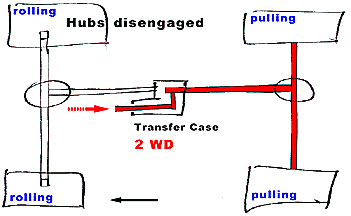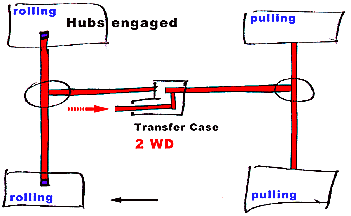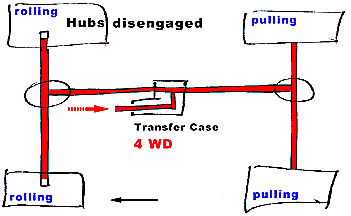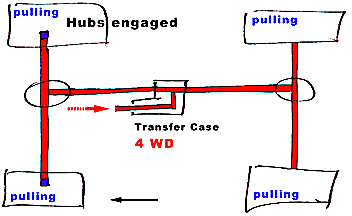When should you lock your hubs?
When should you unlock them?
Could you leave them locked?
Locking hub were invented to engage/disengage the front wheels from the front axle shafts. Idea was to keep parts that were not needed in 2WD mode from rotating in order to reduce mechanical drag and thus save gas.
Good idea but the savings are extremely minimal.
A proposed additional benefit of locking hubs is less wear and tear of front axle parts.
Lousy argument! Are they saying that your front axle components are not strong enough to constantly rotate like your rear axle, and need to be disconnected if not in use? Hmmmm...
An often overlooked draw back is that hubs stick out and can get damaged when off-road. Hub components are usually cast aluminum that break easily. A broken hub could leave you stranded in the back country.
So, what should you do?
I would recommend that you leave your locking hubs disconnected when there is no need for 4WD in sight. You'll achieve a quieter ride on pavement with less vibrations with hubs unlocked. Lock them as needed for 4WD operation (doesn't matter whether you lock them before you shift into 4WD or right after) and unlock them when going back to 2WD (again, doesn't matter whether you unlock them before shifting out of 4WD or right after). Leaving them locked while in 2WD will have no negative effects.
I would recommend you leave your hubs locked while in 2WD during bad weather seasons. This will allow you to shift in and out of 4WD whenever the need arises. Good news is that you will not need to stop for shifting into 4WD - with the locking hubs engaged the drive lines are synchronized. Leaving your hubs locked will cause no damage to your vehicle and will not influence it's handling.
However, driving with part time 4WD engaged (if you have hubs - you have part time 4WD) on dry sections of pavement you will not only create unsafe driving due to understeer - you may also cause expensive repairs due to "drive line bind".
By the way, locking hubs do not create more traction. They are not to be confused with differential locks!

In 2WD with locking hubs disengaged rear drive shaft, rear differential and rear axle are rotating. Front tires are rolling along - only rear tires are pulling. Red lines indicate rotating parts.

In 2WD with locking hubs engaged front drive shaft, front diff and front axle, rear drive shaft, rear diff and rear axle are rotating. Front tires are rolling along (since connected to the axle, they make the front drive line parts rotate) - only rear tires are pulling.

In 4WD with hubs disengaged front drive shaft, front diff and front axle, rear drive shaft, rear diff and rear axle are rotating. Front tires are rolling along (the transfer case makes the front drive line parts rotate, but since the wheels are disconnected the power flow does not reach the tires) - rear tires are pulling.

In 4WD with hubs engaged front drive shaft, front diff and front axle, rear drive shaft, rear diff and rear axle are rotating. Front tires are pulling - rear tires are pulling.
|